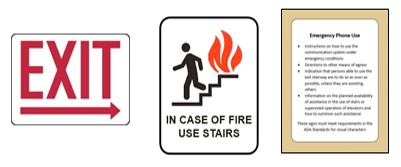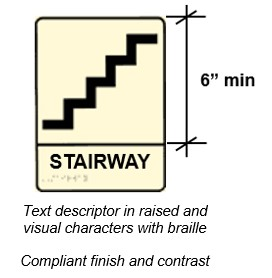Signs [ADA Standards §216, §703]
The ADA Standards cover tactile and visual features of signs, including those that serve means of egress. Only certain signs are subject to requirements for tactile and visual access, while a broader range is subject to the visual criteria only. Tactile signs must include compliant raised characters and braille characters and be located at doors 48” to 60” above the floor or ground (§703.2). Visual criteria address the height, style, proportion, and spacing of characters, as well as finish and contrast, line spacing, and other features (§703.5). Tactile and visual requirements can be met on the same sign or on separate signs.
Tactile and Visual Signs [ADA Standards §216.2, §216.4.1]
The IBC requires exits and exit access doors to be marked by illuminated exit signs (§1011, §1003.2.10). In addition, the IBC requires a tactile “EXIT” sign adjacent to the door to an egress stairway, an exit passageway, and the exit discharge (§1011.3, §1003.2.10.3 – 2000 addresses doors to egress stairways only). The ADA Standards include a similar requirement for visual and tactile exit signs at doors at exit stairways, exit passageways, and exit discharge (§216.4.1). (An exit passageway is a horizontal component of an exit that is separated from interior building spaces by fire-resistance-rated construction that leads to the exit discharge or public way.)
The ADA Standards also require that signs identifying “permanent rooms and spaces” meet tactile and visual criteria (§216.2). This requirement applies to signs identifying stairways, floor levels, and areas of refuge.
Examples of Signs Required to Meet Tactile and Visual Criteria
Exit signs (located at exits) and signs identifying permanent spaces, such as stairways, floor levels, and areas of refuge, are required to meet tactile and visual criteria. Signs providing direction to such spaces and to exits must comply as visual signs, but not as tactile signs. Instructional content included on signs, such evacuation instructions, also must meet visual criteria but not those for tactile characters.
Visual Signs [ADA Standards §216.3, §216.4.2, §216.4.3]
Signs providing direction to, or information about, interior rooms and spaces must meet visual criteria in the ADA Standards, but are not required to be tactile (§216.3). This requirement applies to information about spaces, such as rules of conduct and evacuation instructions, exit route maps, and directional signs to exits and other elements and spaces.
The ADA Standards specifically apply these requirements to signs providing directions to accessible means of egress required by the IBC (§1007.7 (2003), §1003.2.13.6 (2000). The IBC requires that such signs be provided at elevators serving accessible spaces and those exits that do not provide an accessible means of egress. Other directional egress signs provided, including egress route maps, also must meet requirements for visual signs in the ADA Standards. In addition, the ADA Standards apply the visual criteria to posted instructions in areas of refuge required by the IBC (§216.4.2).
Examples of Signs Required to Meet Visual Criteria Only
Visual criteria, but not tactile criteria, apply to directional signs, informational
signs, rules of conduct signs, and posted instructions.
Pictograms and Symbols of Accessibility [ADA Standards §216.2 , §703.6, §703.7]
Where pictograms are provided to identify a permanent room or space, such as a stairway, they must include text descriptors that comply with requirements for raised characters and braille (§216.2). In addition, the pictogram must meet finish and contrast criteria and be located on a field at least 6” high.
Pictograms that provide information about a room or space, including the International Symbol of Accessibility (ISA), or that are included on directional signs must comply with requirements for finish and contrast but are not required to include the verbal equivalent in raised and braille characters or to be located on a 6” minimum high field. The ISA and other required accessibility symbols must comply with the specified symbol referenced in the ADA Standards.
Pictograms that provide information about a space or that are included on directional signs must meet finish and contrast requirements but are not required to have text descriptors or to be located on a 6” min. high field. The ISA must conform to the illustration in the ADA Standards (§703.7.2.1).





User Comments/Questions
Add Comment/Question